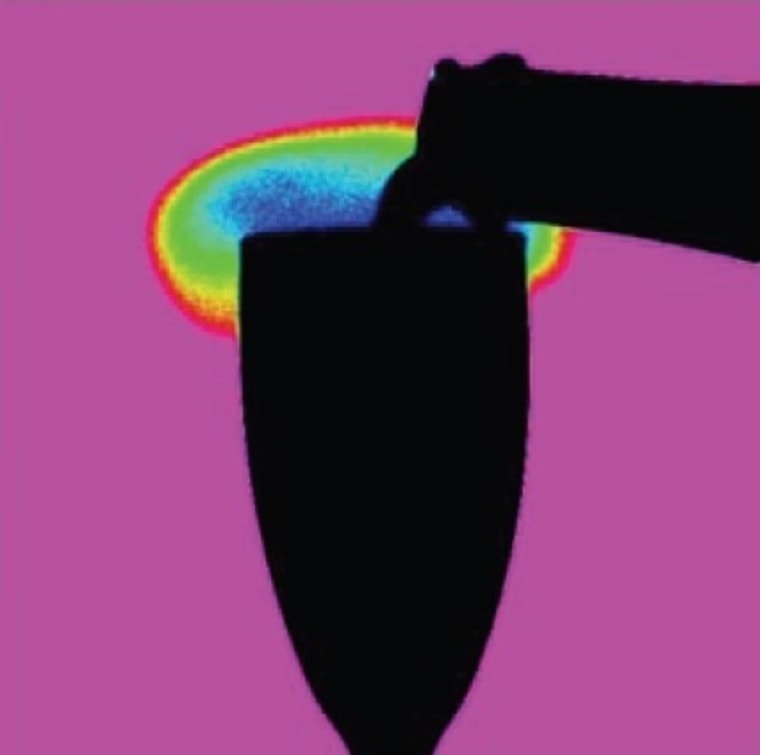
Want to keep the sparkle in that sparkling wine long after the bottle is opened? You don't need to put a cork in it — or a spoon, for that matter. Just keep it cold.
"It will last for days," said Richard Zare, a chemistry professor at Stanford University who has conducted some, um, informal research into bubbly fluids. "It will not go flat. You don't even need to cork it back up. Sure, it's better if you do. But you don't need to."
Zare admits that there's not much of a secret to the trick. The solubility of the carbon dioxide in your sparkling wine is 50 percent greater in the fridge than it is in room temperature. As the wine warms, CO2 evaporates — and there go the bubbles.
Twenty years ago, Zare and other Stanford researchers (and their spouses) used 10 bottles of Champagne wine to test a bit of French folk wisdom: to wit, that putting a silver spoon down into the neck of an opened bottle will keep the Champagne bubbly. After an intense round of taste testing, the research team found that the spoon made absolutely no difference. "The only effect it has is the degree to which it cools the bottle," Zare joked.
Ever since then, Zare has been looked to as an expert on bubble mechanics. The funny thing is that his real job focuses on laser chemistry and molecular interactions that could play a role in cancer therapy. It has virtually nothing to do with bubbles.
"I want to get out of this business," he said of the bubble beat. "The reason I ever got involved in it was really to promote the idea of science outreach to the public."
If you're looking for more of the science surrounding sparkling wine, look no further than "Uncorked: The Science of Champagne," a book written by French wine researcher Gerard Liger-Belair. "I love the beauties behind bubble science," Liger-Belair told NBC News last year. "Since I became a scientist, many people have remarked that I seem to have landed the best job in all of physics, since my research on bubbles requires that I work in a lab stocked with top-notch Champagne — and I'd be inclined to agree."
Take a look at Liger-Belair's latest research on Champagne bubbles, and take these tips to heart if you're popping open a bottle of sparkling wine on New Year's Eve:
- Larger bottles retain more CO2 in the wine as it's being poured into the glasses. So one big bottle is preferable to two smaller bottles.
- Shaking the wine bottle may be a cool thing to do in the Seahawks' locker room, but it's buzzkill for bubbles after the bottle's opened. If you don't care about actually drinking the stuff, a warmer bottle does produce a bigger pop — but be careful where you point that cork.
- The colder the wine, the better it is for the bubbles. If you put an opened bottle in an ice bucket, that will keep more of that fizzy CO2 dissolved in the wine until it's poured.
- Serve the wine in long, narrow flutes rather than wide-brimmed coupe glasses. Flutes concentrate the CO2 as it rises from the wine, giving you a nice snootful of bubbles. A glass flute is better than plastic, which tends to inhibit the fizz.
- For enhanced bubbles, wash your glasses before the party and wipe them dry with a towel. The tiny fibers that are left behind will contribute to bubble production. Some glass-makers add tiny scratches to their Champagne glasses to take advantage of the same principle.
- When it's time to pour, angle your glass and let the wine trickle down against the side. If you slosh it straight into the bottom, more of the bubbles will fizz away before you can take a sip.
- If you want to make a science-minded toast, raise a glass to the memory of 17th-century English scientist Christopher Merret. He's credited with documenting the methode champenoise that makes sparkling wine so lovely. Here's to Dr. Merret!
More about the science of alcoholic drinks:
- Champagne science bubbles up again
- Sip some New Year's Eve science
- How to pour that drink, scientifically
Alan Boyle is NBCNews.com's science editor. Connect with the Cosmic Log community by "liking" the NBC News Science Facebook page, following @b0yle on Twitter and adding +Alan Boyle to your Google+ circles. You can also check out "The Case for Pluto," my book about the controversial dwarf planet and the search for new worlds.
